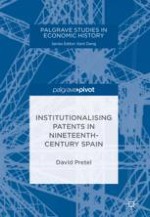2018 | OriginalPaper | Buchkapitel
5. The Colonial Dimension
verfasst von : David Pretel
Erschienen in: Institutionalising Patents in Nineteenth-Century Spain
Aktivieren Sie unsere intelligente Suche, um passende Fachinhalte oder Patente zu finden.
Wählen Sie Textabschnitte aus um mit Künstlicher Intelligenz passenden Patente zu finden. powered by
Markieren Sie Textabschnitte, um KI-gestützt weitere passende Inhalte zu finden. powered by
